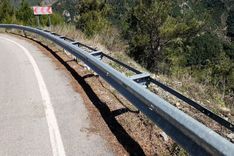As India intensifies its infrastructure development, the demand for road safety installations has grown sharply. Among them, crash barriers, used to prevent vehicles from veering off roads or colliding with hazards; have become a vital part of modern highway design. For micro, small and medium enterprises (MSMEs), this shift presents a rare convergence of business opportunity and national need.
The traditional crash barrier, often made of steel or concrete, is undergoing a transformation. With the introduction of new materials, advanced manufacturing technologies, and evolving safety regulations, MSMEs are well-placed to innovate, compete and contribute to safer roads across India.
Why innovation in crash barriers is a timely business opportunity
The Indian road network, now the second largest in the world, sees the addition of nearly 10,000 kilometres of highways annually. According to the Ministry of Road Transport and Highways, over 150,000 lives are lost on Indian roads each year—many due to lack of adequate roadside protection. In response, the government has mandated the installation of crash barriers on national and state highways, hilly terrain, bridges and black spots.
While large infrastructure firms handle highway design and execution, MSMEs play a crucial role in supplying and fabricating key components. With central and state governments pushing for “Make in India” and localised procurement, MSMEs in metalworking, fabrication, and road safety materials can expand into this high-growth niche.
Modern crash barrier systems and their manufacturing evolution
Crash barriers are broadly categorised into three types: rigid (e.g. concrete walls), semi-rigid (like W-beam steel barriers), and flexible (such as cable barriers). In India, the most commonly used are metal beam crash barriers, typically comprising galvanised steel sheets formed into a W-shape and mounted on steel or concrete posts.
Recent advances have introduced new concepts into this field:
Composite and recycled materials: Fibre-reinforced polymers and recycled plastics are being explored for their impact absorption and environmental advantages.
Smart barriers: Embedded with sensors, these can transmit data post-collision to monitor impact forces and send alerts to control rooms.
Modular barriers: Easier to install, replace and customise depending on site-specific risk.
For MSMEs, the shift from basic fabrication to value-added manufacturing using hot-dip galvanisation, CNC bending, robotic welding and zinc-aluminium coatings represents a pathway to increase margins and quality.
Key manufacturing innovations MSMEs can adopt
1. Hot-dip galvanisation for corrosion resistance
Corrosion is a major concern for roadside installations exposed to weather extremes. Hot-dip galvanised steel provides durability up to 20 years and requires minimal maintenance—an essential trait for government-specified barrier performance. MSMEs can either invest in small-scale galvanisation units or partner with local galvanisers.
2. Cold rolling and forming precision
Modern forming machines with programmable logic controllers (PLCs) offer better uniformity and faster throughput. Cold rolling of W-beam profiles, along with automated punching for bolt slots, helps MSMEs maintain dimensional accuracy as per Indian Road Congress (IRC) and MORTH specifications.
3. Modular jig-based welding
Rather than manual welding setups, modular jigs can improve consistency in posts, base plates and joinery. MSMEs with limited floorspace benefit from reconfigurable jigs that allow faster changeovers and minimal wastage.
4. Quality control and in-house testing labs
As specifications tighten, clients increasingly require pull-out tests, tensile strength validation and galvanisation thickness certificates. Setting up small QC labs enables MSMEs to pass compliance audits and bid for larger orders.
Government regulations and standards to watch
Compliance is key in this segment. The following standards apply:
IRC:SP:84-2014 – for design and installation of metal crash barriers.
IS 5986/IS 2062 – for hot-rolled steel used in fabrication.
ASTM A123 – referenced for hot-dip galvanisation.
In addition, the MORTH’s recent circulars have tightened norms for procurement and installation, especially at accident-prone zones. MSMEs that align with these codes can position themselves as trusted partners for EPC contractors and state highway authorities.
Real-world example: India’s bamboo crash barrier
In 2023, India installed its first bamboo crash barrier—“Bahu Balli”—on a highway in Maharashtra. With polymer treatment, the bamboo structure passed rigorous fire resistance and impact tests. This opens new possibilities for rural MSMEs engaged in agro-forestry or sustainable materials.
It also reflects a broader opportunity: Indian road safety doesn’t have to follow global templates—it can innovate locally.
Challenges MSMEs face—and how to overcome them
Capital constraints: MSMEs often hesitate to invest in forming lines or hot-dip galvanisers. Subsidised loans under schemes like CGTMSE or SIDBI’s Sustainable Finance Scheme can ease entry barriers.
Skill shortages: Operating PLC-driven machines or interpreting CAD-based designs requires skilled technicians. MSMEs can tie up with local ITIs or engage in short-term NSDC-certified programmes.
Volatile steel prices: As steel makes up 60-70% of cost, MSMEs should adopt steel hedging tools or form consortia to bulk procure raw material at negotiated rates.
Tender complexity: Public procurement norms may be daunting. Partnering with aggregators or joining government vendor platforms like GeM can simplify market access.
Digital adoption and marketing for MSMEs
In a competitive tender environment, digital presence matters. MSMEs should invest in:
A well-maintained website listing ISO certifications, plant capacities and recent projects.
B2B directories (e.g. IndiaMART, GeM, JSW One MSME platform).
Google My Business profiles for local discovery by contractors.
In addition, digital inventory systems and barcoded tracking can reduce losses and improve delivery timelines—especially important when working with infrastructure EPC firms.
Road ahead: the promise of public-private collaboration
Several government initiatives—Bharatmala, Gati Shakti and Vision Zero—highlight the growing focus on road safety and intelligent transport systems. While large OEMs may dominate the sensor and software side, MSMEs hold an edge in fabricating rugged, field-tested hardware components like barriers and bollards.
If supported by capital access and technical upskilling, India’s 63 million MSMEs could help reimagine road safety infrastructure—not just for compliance, but for genuine innovation.
Conclusion
Crash barrier manufacturing is no longer about bending steel into a W-shape. It now involves automation, materials science, design innovation and digital integration. MSMEs that embrace this transition can not only build a thriving business but contribute meaningfully to India’s infrastructure safety goals.
The opportunity is real. The technology is accessible. And the road ahead is open—for those ready to manufacture the future, safely.




 +91 7208055523
+91 7208055523
 Help & support
Help & support
